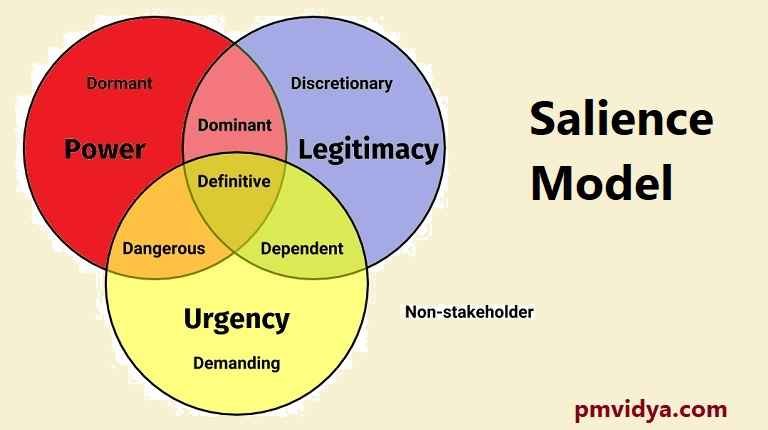A stakeholder is defined as anyone with an interest in your project or program. PMBOK defines a Stakeholder as an Individual or group or Organisation, that may affect or be affected by or perceive itself to be affected by a decision, activity, or outcome of a Project or Program. Not all stakeholders have the same amount of Power or Influence or Interest over the project. So, different Stakeholders should be managed differently as required. Classifying stakeholders based on their attributes will help in this regard for better management. There are different Stakeholder classification techniques and the salience Model is one of them. A Stakeholder Salience model classifies Stakeholders based on their Power, Urgency, and Legitimacy. We shall look at the Salience Model in detail.
Salience Model Stakeholder Classification
The bigger the project, and the more complex the organization in which you’re working, the more attention you should pay to stakeholder management. Irrespective of the nature of the impact that a stakeholder has on the outcome, all project stakeholders should be engaged effectively. This is can make a very critical difference to the success or failure of the project. Even if you manage the project execution perfectly, failure to manage the expectations of a powerful stakeholder can result in your project being perceived as a failure.
Not all stakeholders have the same amount of Power or Influence or Interest over the project. So, different Stakeholders should be managed differently as required. Classifying stakeholders based on their attributes will help in this regard for better management. There are different Stakeholder classification techniques and the salience Model is one of them. A Stakeholder Salience model classifies Stakeholders based on their Power, Urgency, and Legitimacy.
A problem facing project managers, especially in large projects, is how to communicate effectively with all the different stakeholders, who all have competing communication needs that they expect you, as the project manager, to fulfill. The Salience Model attempts to solve this problem by categorizing stakeholders according to their power, legitimacy, and urgency.
- Power – It refers to the ability to influence the project deliverables or the organization
- Legitimacy – It refers to the level of interaction with the project and its appropriateness
- Urgency – It refers to the need for immediate action.
These categories overlap, and we acknowledge this by placing our stakeholders into the following Venn diagram:

As you can see, we have 7 categories of stakeholders in total (excluding non-stakeholders). We can write these groups in order of their prominence and the amount of attention you need to give each type of stakeholder as follows:

The classes of stakeholders which need special attention are those that overlap in the Venn diagram – 4, 5, 6, and 7. Class 4 (Dominant) stakeholders not only have the power but also have a legitimate claim for communication and thus their needs should be taken into account. Class 5 (Dangerous) stakeholders have the power, the need for time-critical updates, but not the legitimacy. You need to pay special attention to these stakeholders and their needs as they could be dangerous to your project otherwise, possibly using their power and influence to build a consensus perception that your project is a failure. Class 6 (Dependent) stakeholders have the urgency and legitimacy but not the power – perhaps these stakeholders are part of your project team. These need to be kept informed. Their urgency and legitimacy can be a great asset to the project.
Class 7 (Definitive) stakeholders are the most important of all. They have the power, the right to demand urgency from you or the organization, and the legitimacy to demand the communication.
As a final note, remember that the different classes of stakeholders can be gained or lost over time, they are not static, so you may need to change how you communicate with different stakeholders as the project progresses.

Waw beautiful and good luck